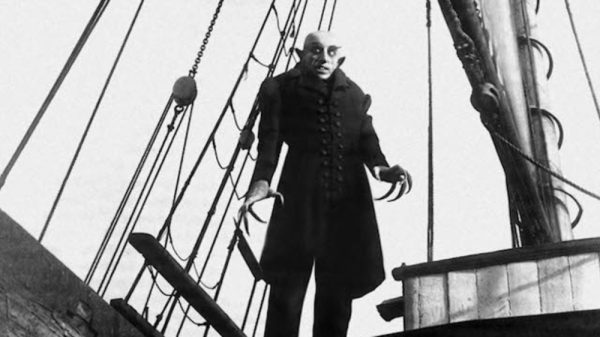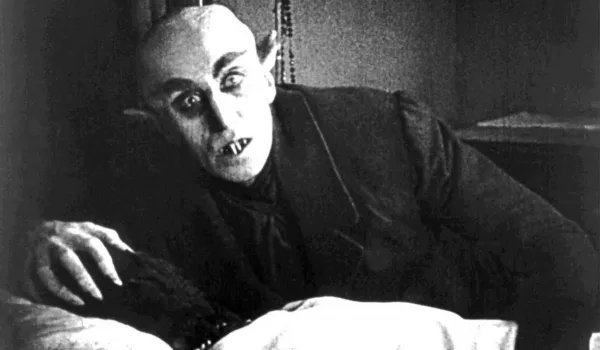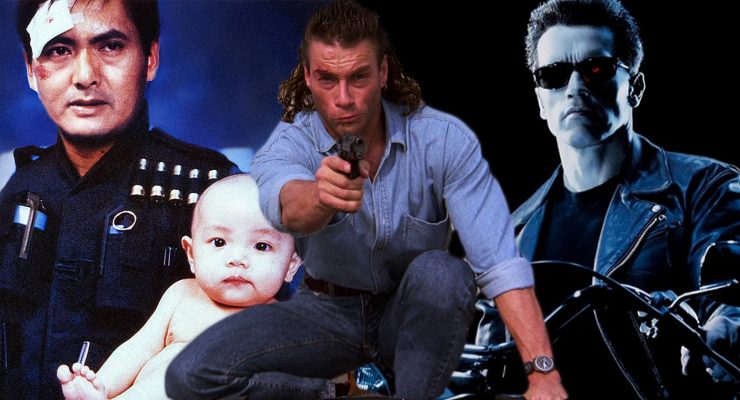Tom Jolliffe looks at the potential greatness lurking within a Robert Eggers version of Nosferatu…
Robert Eggers has blazed a trail to the forefront of folk horror. His very auteur approach to horror cinema belies some of the cheaper tricks that other modern horror film-makers might rest on. Eggers has never been about jump scares or manipulative editing. Alongside Ari Aster, he’s becoming something of a magnetic director in the genre. Right now, Eggers is bringing to life a Viking saga with The Northman, his all-star epic that promises to be enthralling.
So how has Eggers got to the point where cinephiles find themselves struck with baited breath, awaiting his next film? It began with The Witch. Given the title, and the era, many might have expected yet another of those spooky and ghoulish horrors with lots of jumps, a manipulative soundtrack and a big reliance on forcing tension upon an audience with quick cutting and extreme cinematography. They might have expected a more overt and titular villain. Standard horror fare isn’t at all to be sniffed at of course, whilst some of the themes making the rounds at the moment often lend themselves to more generic approach. However from The Witch, moving onto The Lighthouse there has been something of a consistency.
Eggers has crafted films that feel distinctly like folk tales brought to life. Folk tales create the backbone to his enthralling and equally enigmatic visions. On the one hand we have Anya Taylor-Joy in a breakout role with The Witch. A family sets up camp at the edge of a remote forest with no one else around. Increasingly their land becomes baron, crops die and something sinister seems to be effecting them. The distinctly archaic dialogue with an odd blend of Shakespearean and olde Yorkshire dialect was unique, but harking back to an era of folk tales and stories. Though set in England too, there’s a further infiltration of some European folklore within the story too. The film actually proved a little divisive among younger audiences drawn to more distinctly ‘horror’ infused trailers and exceptional ratings from critics (perhaps they expected something more akin to The Conjuring). There’s a sense the film might have been miss-sold in the marketing. Ultimately some audiences, with more expectation for some more generic shock based horror, felt undersold with Eggers’ slow burning folk horror that was evasive in its outcome. On the flipside though, the people who tuned into the films vision will often rate it as a masterwork in the genre.
To a lesser extent this happened again in The Lighthouse. Whilst the press materials and trailers didn’t push the notion of a more overt horror, it probably didn’t quite lay out the curious side of his cabin fever masterpiece (which has some parallels with Kubrick’s The Shining and may well represent the best cabin fever horror since). Still, like The Witch this film incorporated a hodge-podge of myth, legend and folk tale into its horror story. It focused on the enigma and oddity of folk stories, over changing them into hard horror creations. The notion of a Michael Myers could well carry aspects from an array of myths, legends of folk tales, but these aren’t always about scaring one witless. Sometimes it’s about creating a mood, atmosphere or intrigue. In the horror genre, the standard default is to create shock or scares. There’s perhaps a reason horror has perennially been seen as a lesser genre and it lies in the notion that it can be one dimensional. Creature vs protagonist. The horror director has many tools at their disposal, from the DP, to composer, editor, and visual effects crew. They can load a film with gore or jump cuts, and portray a simple tale of survival against the odds. So the wont of the horror director, with their Myers in tow, is to focus more directly on the propensity of fear within the audience. In saying that, John Carpenter was the master craftsman in genre cinema for a time, and The Thing particularly had an extra layer beneath the surface, an insular look at human behaviour, whilst he showed an innate, almost Kubrickian gift, for creating lingering, brooding, discomforting atmosphere.
Eggers is all about atmosphere. The Witch might be a tight run time but within that, Eggers slowly lures you into a very simple and distinct setting. Initially drab, gray and colourless, we become ingratiated into this nondescript setting on the border of woodland. The slow breakdown of some of the characters becomes uncomfortable, tense and again, focused on a sense of increasing dread over dispersing quick releases of horror as the genre default would usually require. Like The Shining, Eggers created The Witch and The Lighthouse with an overriding and perpetual feeling of creepiness. It starts at a low level, and increases to the final points of release when the moments you can define as ‘horror’ finally happen. The worlds he has created, in such confined settings, contributed to two of the best horror films of the century. A big part of that is down to the very fact they don’t often play into the very archetypes you expect from horror. They certainly build to violence and death, two horror staples, but much like Kubrick, the journey becomes important, with a very minute attention to detail that the perfectionist auteur rarely brings to the genre.
So it brings us now to the very mouthwatering prospect of another potential masterpiece. Nosferatu may well be overdue its latest incarnation. The original Murnau film was of course loosely based from Bram Stoker’s Dracula, redefining the story and etching a very distinct visual depiction to the origins. Werner Herzog later made his own version, re-imagining Murnau’s take on Dracula. Which source Eggers more firmly roots his new version remains to be seen. Will it own more to Murnau, Herzog, or revert even more to Stoker? We’ve probably had the more archetypical Stoker-led versions with more regularity over the last 100 years of cinema. The widow peak and cape is perhaps a little quaint in todays standard, whereas Murnau’s visual had a very definitive and European folky influence to it preceding even Stoker’s tale. Then again, Eggers may well create his own very distinct vision that will feel at once modern but also refreshingly old fashioned too. He’ll make a film in a way that harkens back to an efficiency of camera use, movement and of refrained editing. At least, I suspect he will going by his work so far. I would definitely expect a recreation of certain infamous moments (Nosferatu’s shadow creeping up the stairs etc).
What will be very interesting is whether Eggers chooses to shoot in black and white or not. Could he also choose to shoot on old film stock and the old academy ratio again (eg, The Lighthouse)? Has that ship sailed? I wouldn’t be adverse to seeing him shoot in black and white, and even if not on older lenses and stock, it would certainly be great to see him shoot on film again rather than going to digital. Will he retain the narrow frames of The Witch (1.66:1) and The Lighthouse (1.19:1)? Not much is known about The Northman yet as far as his visual design. One might assume the larger budget and more expansive landscape photography associated with epics would lend itself to widescreen, but you never know. Indeed the potential insular nature of another Nosferatu film could well lend itself to a narrower frame, to help create the claustrophobic feeling once more. The narrower frame traps that tension in, the frame tightly wrapping its subjects and increasing the intense psychological discomfort. Of course tension can still be achieved through wider frames, showing that yin yang between wide expanses and the subject within. You can create a disassociation between the subject and location. A feeling of alienation perhaps. Undoubtedly Eggers and his DP (we might assume, Jarin Blaschke again) will know exactly what they want to achieve via their framing and lenses.
Just who Taylor-Joy will play is also a mystery at the moment but it would be safe to say she will be prominent. Much of what Eggers has created so far plays a lot on what is unsaid. Even a film like The Lighthouse which has lengthy dialogue passages, also has dark caveats of hidden meaning beneath those lines, amplified by exceptional performers. As Taylor-Joy also proved in The Witch, she’s absolutely mesmerising to watch. A film that will cover European folklore (perhaps with some further Nordic influences if there’s any Northman/Lighthouse hangover) and create an engrossing and distinct world (indeed also working on an assumption it’ll have an historical setting). Whatever the resultant film-making choices, I feel confident though, that Eggers is going to nail the landing once more and create yet another atmospheric masterpiece of folk horror.
Tom Jolliffe is an award winning screenwriter and passionate cinephile. He has a number of films out on DVD/VOD around the world and several releases due out in 2021/2022, including, Renegades (Lee Majors, Danny Trejo, Michael Pare, Tiny Lister, Nick Moran, Patsy Kensit, Ian Ogilvy and Billy Murray), Crackdown, When Darkness Falls and War of The Worlds: The Attack (Vincent Regan). Find more info at the best personal site you’ll ever see here.

















